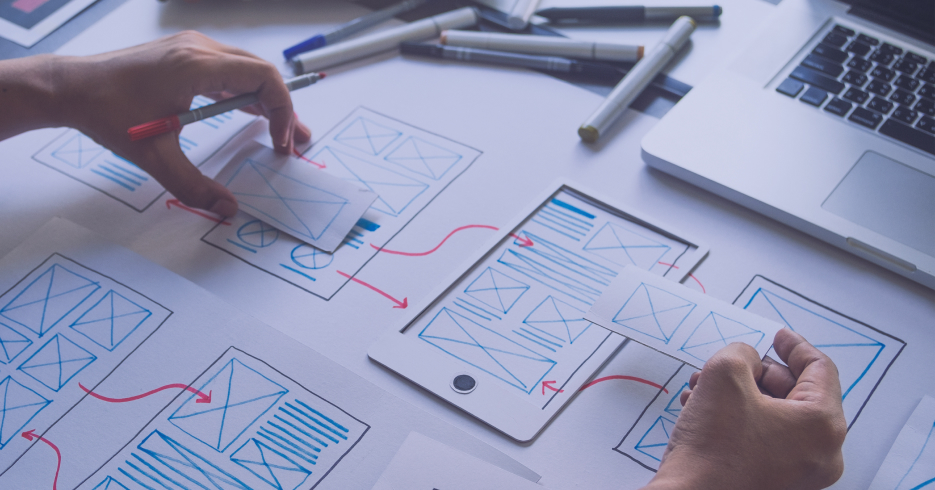The modern business world is fast-paced and ever-evolving, and now more than ever, businesses are constantly competing to stay ahead of their competition. UI/UX design has quickly become the determining factor of the success of digital products. UI/UX turn to “prototyping” to ensure the final product’s success. Prototyping is a technique that breathes life into concepts and ideas, transforming them into interactive, dynamic representations of the final product.
Unravelling UI/UX Design
User Interface (UI) and User Experience (UX) are inseparable components that together shape the digital experience of a product or service. UI design emphasises the visual elements, such as aesthetics and interactivity, while UX design aims to enhance user satisfaction by improving usability and accessibility. When combined, they deliver a cohesive, intuitive, and captivating user experience tailored to the target audience.
The Power of Prototyping
Prototyping is a game-changing technique in the UI/UX design process. It transforms static ideas into interactive models, providing a tangible, dynamic representation of the final product. Prototypes bridge abstract concepts and their practical implementation, allowing designers, stakeholders, and users to visualise, test, and iterate the design before actual development begins.
Marli, a UI/UX Design Lead here at Warp shares the following: “Our process of designing successful digital products always includes a critical step: prototyping. This phase applies the foundation for a user-centred product and embodies the principles of design thinking—a mix of ideology and methodology that places user needs at the forefront of problem-solving. In our approach, prototyping is more than just a step; it’s a philosophy that allows us to explore solution-focused strategies, navigate through challenges, and foster an environment ripe for innovation, iteration, and creative thinking. By placing the user at the centre, we ensure that the product equally addresses the needs of stakeholders and meets technical specifications.”
Diving into the Evolution of Design Prototyping
Prototyping has come a long way, from simple paper sketches to advanced digital simulations. Today, digital prototypes provide users with a near-real-life experience of the final product, bridging the gap between design and functionality. It allows designers, developers, and stakeholders to interact with the product, simulate user scenarios, and make informed decisions before a single line of code is written.
The Merits of Prototyping in UI/UX Design
- Facilitating Communication and Collaboration
Prototyping catalyses effective communication between designers, developers, and clients. It offers a tangible reference point for discussions, making conveying design ideas, interactions, and user flows easier. With the advent of collaborative prototyping tools, teams can work together seamlessly, regardless of their geographical location, fostering a remote-friendly work environment.
- Early Detection of Design Flaws
Prototypes reveal design flaws and usability issues early in development, saving time, effort, and resources that would otherwise be spent on fixing problems later. Testing design concepts with real users through interactive prototypes allows designers to validate their ideas and gain valuable insights for iterative improvements.
According to Marli, our UI/UX Design Lead: “The value of prototyping in our process cannot be overstated. It provides a safe space to test concepts and system designs before engaging in the costly and time-intensive phases of development. This phase is crucial because it often reveals discrepancies between theoretical assumptions and user expectations. By engaging with real users early on, without the significant investment of resources typically required, we gain vital insights into usability issues, setting the stage for informed decision-making and iterative design refinement.”
Bridging the Gap Between Designers and Stakeholders
Prototypes serve as a bridge between designers and stakeholders. Instead of relying solely on abstract descriptions, stakeholders can interact with a tangible design representation. This interaction leads to more precise feedback and a shared understanding of the product vision.
Marli, our UI/UX Design Lead shares some valuable insight into a common challenge she has encountered by saying: “One of the most transformative aspects of prototyping is its ability to bring abstract concepts to life. Despite extensive UX research and technical planning, we’ve noticed a common challenge: stakeholders and team members sometimes need help to fully grasp a concept until they can interact with a tangible representation. This interaction is where prototyping shines, offering a bridge between idea and reality. Presenting prototypes to stakeholders garners valuable feedback and data for design iteration and helps visualise the product, fostering discussions around business workflows, technical feasibility, and budget considerations.”
At Warp Development, we harness the power of prototyping to deliver exceptional UX/UI design solutions that resonate with users. Contact us here to learn how our expert UI/UX design solutions can enhance your user experience and drive business growth.
Remember, prototypes are the blueprint of your final product. They provide a solid foundation upon which to build your digital masterpiece. So, leverage the power of prototypes and let your design ideas come to life!



